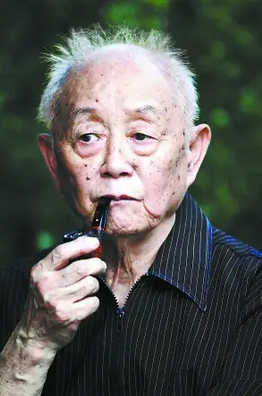Huang Yongyu (August 9, 1924 – June 13, 2023), pen names: Huang Xingbin, Huang Niu, Niu Fuzi. Born in Changde County, Hunan Province (now Dingcheng District, Changde City), ancestral home: Fenghuang County, Hunan Province. Member of the Tujia ethnic group. Academician of the China National Academy of Painting, Professor at the Central Academy of Fine Arts, former Director of the Printmaking Department. Member of the China Artists Association. [13]
Huang Yongyu received elementary school education and an incomplete junior middle school education. Due to poverty, he left home at age 12 to seek livelihood, wandering to small porcelain workshops in the mountainous regions of Anhui and Fujian as a child laborer, later moving辗转 to Shanghai, Taiwan, and Hong Kong. He began publishing works at age 14, and for a period thereafter focused primarily on printmaking, achieving fame both domestically and internationally for his uniquely styled prints. At age 16, he began earning a living through vivid painting and woodcuts. He once worked as a small worker in a porcelain factory, elementary school teacher, middle school teacher, member of a folk education institute, apprentice artist in a theater troupe, newspaper editor, film screenwriter, and professor at the Central Academy of Fine Arts, Vice Chairman of the China Artists Association, and Consultant of the 9th China Artists Association. [1] Honorary Member of the 10th China Federation of Literary and Art Circles.
On June 4, 2020, Huang Yongyu ranked 17th on the “2020 Hurun China Art List” with a total auction turnover of RMB 37 million in 2019. [2] On August 16, 2021, People’s Literature Publishing House announced the pre-sale of Huang Yongyu’s new book and celebrated his birthday (lunar calendar). [10]
At 3:43 a.m. on June 13, 2023, Huang Yongyu passed away.
Due to poverty, he left home at age 12 to seek livelihood, wandering to small porcelain workshops in the mountainous regions of Anhui and Fujian aschild laborer, later moving辗转 to Shanghai, Taiwan, and Hong Kong. He began publishing works at age 14, and for a period thereafter focused primarily onprintmaking, whose uniquely styled print works gained renown both domestically and internationally. At age 16, he began earning a living through vivid painting and woodcuts.
He once served as a small worker in a porcelain factory, elementary school teacher, middle school teacher, member of a folk education institute, apprentice artist in a theater troupe, newspaper editor, film screenwriter, andCentral Academy of Fine Arts professor,China Artists Association Vice Chairman. Besidespainting, Huang Yongyu was also proficient in seal carving, with a潇洒出尘 style that left viewers in awe; however, he never carved seals for others throughout his life, having made only two seals for friends: one was a gold script book seal “梅溪collection” created for his wife Zhang Meixi in 1950; the other was made in recent years. In the essay “Anecdotes of a Painter” in “Pingwa Prose” (Zhejiang Literature and Art Publishing House, first printing April 2008), it was mentioned that Mr. Huang Yongyu entrusted Mr. Shi Nan to deliver a stone seal (crafted by Qian Shoutie of Shanghai) to Mr. Shi Lu, seemingly this very stone seal. In 1952, Huang Yongyu returned toBeijing with his wife Zhang Meixi from Hong Kong and was assigned to work at the Central Academy of Fine Arts. He successively held positions such asassociate professor, professor, and Vice Chairman of the China Artists Association. In 1956, he published “Huang Yongyu Woodcut Collection,” whose masterpieces “Spring Tide” and “A Shima” caused a sensation in theChinese painting world. During the Cultural Revolution, he was accused by the “Gang of Four” as areactionary academic authority and subjected to criticism. Later, he suffered brutal persecution for painting “Owl” at the Beijing Grand Hotel and was sent back to his hometown Fenghuang. After the fall of the Gang of Four, he returned to Beijing. Huang Yongyu excelled inprintmaking and primarily focused on Chinese painting, with his works characterized by unique conception and profound artistic attainment. In 1978, Britain’sTimes devoted six pages to aspecial featurereport on Huang Yongyu and his art. In 1980, “Huang Yongyu Painting Collection” was published by the Hong KongArtists Publishing House. Multiple domestic publishers subsequently released Huang Yongyu’s albums including “Xiangxi Sketches,” “The Landscape That Never Returns,” “Huang Yongyu,” and others. Huang Yongyu was self-taught inart and literature, earning the reputation as a “genius.” He designed the universally recognized Year of the Monkey stamp and the packaging forJiugui liquor. His published works include “Yongyu Six Records,” “Drunk Eight Immortals,” “Wu Shimang Forum,” “Wife, Don’t Cry,” “These Melancholy Fragments,” “Along the Seine to Florence,” “The Landscape Under the Sun,” and “The Wandering Man of the Wuchou River.” He painted “A Shima,” the Year of the Monkey zodiac stamp, and the landscape painting for the Chairman Mao Memorial Hall. He held exhibitions inAustralia, Germany, Italy, mainland China, and Hong Kong. His artistic achievements were honored with the Italian Commander’s Award. He enjoys high acclaim both at home and abroad. Huang Yongyu has always held deep affection for his hometown. In recent years, though he traveled extensively around the world, he never forgot hishometown—the beautifulFenghuang Town. He believed that one’s hometown is the cradle of emotion, its influence lasting a lifetime; it is one’s own bed, perhaps not fragrant, yet the most familiar and irreplaceable scent. In a poem, he wrote: “...My blood is type O; whoever takes it will suit. My heart, only my heart, dear hometown, belongs to you...” On the afternoon of August 31, 2010, at the Fangfei Garden of the Diaoyutai State Guesthouse in Beijing, Huang Yongyu was appointed Director of the Printmaking Department of theChina National Academy of Painting. [3] Honorary Member of the 10th China Federation of Literary and Art Circles [4]

 中文
中文  en
en 
